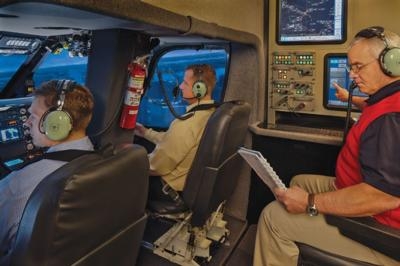Tue, Nov 01, 2016
Builds On The Fundamentals Covered By Initial And Recurrent Training
FlightSafety International announces the introduction of its Master Aviator program for helicopter pilots. The progressive Master Aviator curriculum builds upon the fundamentals covered by initial and recurrent training. FlightSafety Master Aviator for helicopter pilots is earned by completing two advanced aircraft-specific core courses and a choice of four electives. At least one FlightSafety initial or recurrent training event must also be completed every 8 months.

“We are pleased to now offer the FlightSafety Master Aviator program for helicopter pilots,” said David Davenport, Executive Vice President. “Master Aviator sets a new standard for pilot achievement and recognition, and helps pilots to develop a deeper knowledge of the helicopter they fly and to ensure a safe and correct response to a broad range of demanding, unexpected situations.”
The one-day core courses include Helicopter Human Factors / Crew Resource Management (HF/CRM) and Surviving Inadvertent Instrument Meteorological Conditions (IMC). The CRM course enables the pilots to master the key aspects of CRM that uniquely apply to helicopter operation. This includes situational awareness, conflict resolution and communication skills. They will also experience how effective crew performance and decision-making can overcome situations caused by error chains, human factors and fatigued or stressed operators.
The IMC course will help the pilots to be fully prepared when weather conditions unexpectedly and rapidly change in order to have sound and well-practiced strategy to maintain the safety of their aircraft. This course provides the tools needed to react appropriately as decisions made in the first pivotal moments often decide the outcome. Pilots will also review and fully understand the major causes for inadvertent IMC accidents and master best practices for the safest responses.
The elective courses include Helicopter/Rotary Wide Area Augmentation System (WAAS) and Automatic Dependent Surveillance-Broadcast (ADS-B); Fatigue Management; Safety Management Systems for Aviation Professionals; Air Medical Resource Management; Warm Weather Operations; Cold Weather Operations; Adverse Weather and Monsoon Conditions; Helicopter Approach and Landing Accident Reduction (ALAR); and Controlled Flight Into Terrain (CFIT). Other specialty and enrichment courses include General Emergency Training; Night Vision Goggles (NVG) Initial and Recurrent; Corporate Aviation Security; Hazardous Materials (Will Not Carry); Safety Management System (SMS) for Managers; and Weather Radar.
(Source: FlightSafety news release)
More News
“While legendary World War II aircraft such as the Corsair and P-51 Mustang still were widely flown at the start of the Korean War in 1950, a new age of jets rapidly came to >[...]
Decision Altitude (DA) A specified altitude (mean sea level (MSL)) on an instrument approach procedure (ILS, GLS, vertically guided RNAV) at which the pilot must decide whether to >[...]
Aero Linx: National Aviation Safety Foundation (NASF) The National Aviation Safety Foundation is a support group whose objective is to enhance aviation safety through educational p>[...]
Also: Cal Poly Aviation Club, $$un Country, Arkansas Aviation Academy, Teamsters Local 2118 In response to two recent general aviation accidents that made national headlines, more >[...]
“The FAA is tasked with ensuring our skies are safe, and they do a great job at it, but there is something about the system that is holding up the medical process. Obviously,>[...]
 Aero-News: Quote of the Day (04.28.25)
Aero-News: Quote of the Day (04.28.25) ANN's Daily Aero-Term (04.28.25): Decision Altitude (DA)
ANN's Daily Aero-Term (04.28.25): Decision Altitude (DA) ANN's Daily Aero-Linx (04.28.25)
ANN's Daily Aero-Linx (04.28.25) Airborne-Flight Training 04.24.25: GA Refocused, Seminole/Epic, WestJet v TFWP
Airborne-Flight Training 04.24.25: GA Refocused, Seminole/Epic, WestJet v TFWP Aero-News: Quote of the Day (04.29.25)
Aero-News: Quote of the Day (04.29.25)



